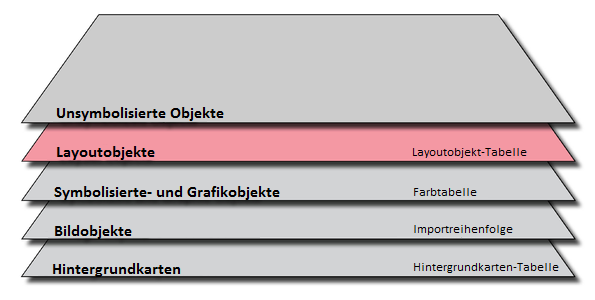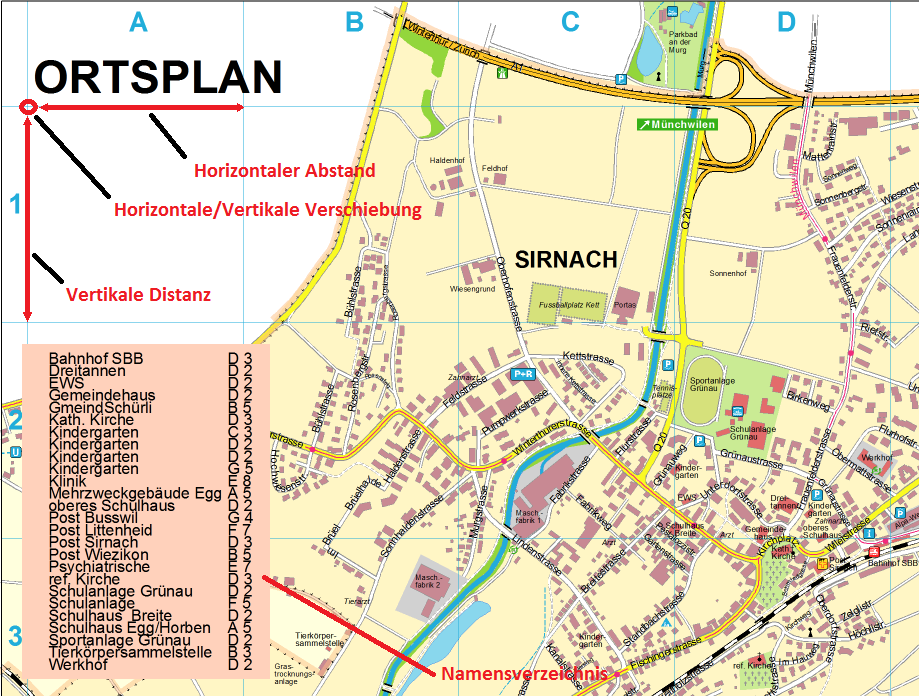Layout

|
In OCAD 11 a layout layer has been added. This layer may contain raster images and vector objects like lines, areas or text. The vector layout objects color model is CMYK. The layout images' one is RGB. Spot colors are not supported by the OCAD layout layer.
Layout objects cannot be selected, moved, removed or changed unless you choose the Edit Layout Objects command in the Layout menu.
Edit Layout Objects
Use this function in the Layout menu to add, remove or edit layout objects and define their properties. The Edit Layout Objects dialog appears on the right side of the window. Now you can move, edit or remove layout objects in the drawing area like normal objects.
Add a line, area or text layout object:
- Click the Line, Area or Text icon in the Edit Layout Objects dialog as a Type.
- Choose a Color. Click the color field to define the color with the Color Picker.
- If you have chosen a line, define the Line width in the Line properties category in mm. If you have chosen a text, choose a Font and a Text size in the Text properties category.
- Draw the layout object with the regular drawing tools.
To edit the drawn layout object select it and change the properties (color, line width etc.) in the Edit Layout Objects dialog or use the editing functions of OCAD (Edit Object).
Add an image:
- Click the Add button in the Images category of the Edit Layout Objects dialog.
- The Add Layout Image dialog opens and you can browse an image. The supported image files are .bmp, .dib, .gif, .jpg, .png, .tiff. Click the Open button to add the image.
![]() - Move or resize the layout image by double-clicking the item in the layout objects list.
- Move or resize the layout image by double-clicking the item in the layout objects list.
- - Remove a layout image by selecting it in the layout objects list and clicking the Remove button in the Images category of the Edit Layout Objects dialog.
- - The error message "Layout font attributes list is full" appears if the list contains the maximum of 256 entries.
- - All Layout objects are listed in the layout objects list. It is possible to set them visible or hidden and to move them up and down.
- - The error message: "Font not found" appears if a layout object is linked to a font that is not installed on the PC. The font needs to be installed on the PC or another font must be chosen. Otherwise the font Arial is used.
Import Layout
Choose this command in the Layout menu to import the layout objects from another OCAD map. The layout objects are placed in the center of the actual drawing area. This command is only available if you are in the Edit Layout Objects mode.
Save Layout
Choose this command from the Layout menu to save the layout objects to a separate OCAD file. This command is only available if you are in the Edit Layout Objects mode.
Hide
Select Hide in the Layout menu to hide all layout objects.
Add North Arrow or Scale Bar
You can add predefined north arrows or scale bars to the Layout.
- Choose Edit Layout Objects in the Layout menu.
- Choose Add North Arrow or Scale Bar in the Layout menu.
- The Add North Arrow or Scale Bar dialog appears and you can choose between different north arrows and scale bars from the Templates folder of the OCAD directory (Usually C:\Program Files\OCAD\OCAD 11 Edition\Templates).
- Click the Open button to add the selected object to the layout objects.
![]() - In the OCAD directory you can find a PDF-File with an overview of all predefined north arrows and scale bars (Usually C:\Program Files\OCAD\OCAD 11 Edition\Templates).
- In the OCAD directory you can find a PDF-File with an overview of all predefined north arrows and scale bars (Usually C:\Program Files\OCAD\OCAD 11 Edition\Templates).
- - North arrow and scale bar templates are black. You can change the color after adding them by choosing a color from the color field in the Edit Layout Objects dialog.
Add an Own North Arrow or Scale Bar
Coming soon...
Add Map Legend
Choose the Add Map Legend function from the Layout menu to create a Map Legend. The Add Map Legend dialog appears.
Legend Icon
Define values for the legend icon in this part of the dialog. You have to set a value for the Icon height, the Icon width and the Line spacing. If you want that only used symbols are shown in the legend, check the corresponding box. In the same way, you can decide wheter hidden symbols are shown in the legend or not.
Symbol type
Only the checked symbol types are taken into consideration for the map legend. Click the All button to check or click the None button to uncheck all symbol types.
Legend Text
Choose a symbol for the legend text. This must be a text symbol of course. If you want that the symbol number is shown in the legend text, check the corresponing option.
Click the OK button to add the map legend.
![]() This function creates symbolized map objects, not layout objects. Use the function Convert to Layout Object to convert them into layout objects.
This function creates symbolized map objects, not layout objects. Use the function Convert to Layout Object to convert them into layout objects.
Add Trim and Bleed Marks
This command adds trim and bleed marks as layout objects to the map.
- The easiest way to add trim and bleed marks is when you set the ruler guides to the border of the map and the map layout (e.g. A4 landscape format) first. Learn how to use the ruler guides on the Ruler Guides page. If you do not want to use Ruler Guides skip this step.
- Choose the Add Trim and Bleed Marks function in the Layout menu.
- The Add Trim and Bleed Marks dialog opens.
- If you are using Ruler Guides, click the Get ruler guides coordinates button in the Trim marks part of the dialog and then click the Add button. Trim marks with the coordinates of the ruler guides are added. If you are not using Ruler Guides, enter the paper coordinates for the trim marks manually and then click the Add button.
- Enter the offset for the bleed marks in the Bleed marks part of the dialog if you want to add them. Then click the Add button.
- Click the Close button to apply all adjustments and quit the dialog.
Trim and Bleed Marks are layout objects and can be edited and removed like a layout object.
Create Graticule Name Index
This command is only available if the map is georeferenced and a coordinate system is set. The command calculates a name index based on the WGS84 graticule.
Select one or more symbols in the symbol box before choosing the command. All text objects and line text objects with these symbol(s) are included to the index.
Create Graticule Name Index Dialog
- Index origin of longitude/latitude: Enter index origin coordinates.
- Horizontal/vertical distance: Enter the distance between the grid lines.
- Angle: Enter the angle of the grid. This angle is normally zero.
- Style: Choose a numbering style. One axis is always numbered "A, B, C..." and the other "1, 2, 3..."
- Name index symbol: Choose a text symbol. It is used to draw the graticule name index on the map.
After clicking the OK button a text object with the index will be added in the center of the drawing area.
![]() This function creates symbolized map objects, not layout objects. Use the function Convert to Layout Object to convert the index to layout objects.
This function creates symbolized map objects, not layout objects. Use the function Convert to Layout Object to convert the index to layout objects.
![]() Create WGS84 Grid is the corresponding function to create a graticule.
Create WGS84 Grid is the corresponding function to create a graticule.
Create Name Index
Select one or more symbols in the symbol box before choosing the command. All text objects and line text objects with these symbol(s) are included to the index.
Create Name Index Dialog
- Horizontal/vertical offset: Enter the coordinates of the upper left or lower left corner where the numbering of the grid starts.
- Horizontal/vertical distance: Enter the distance between the grid lines.
- Angle: Enter the angle of the grid. This angle is normally zero.
- Style: Choose a numbering style. One axis is always numbered "A, B, C..." and the other "1, 2, 3..."
- Symbol: Choose a text symbol. It is used to draw the name index on the map.
After clicking the OK button a text object with the index will be added in the center of the drawing area.
![]() This function creates symbolized map objects, not layout objects. Use the function Convert to Layout Object to convert the index to layout objects.
This function creates symbolized map objects, not layout objects. Use the function Convert to Layout Object to convert the index to layout objects.
![]() Create Map Grid is the corresponding function to create a rectangular map grid.
Create Map Grid is the corresponding function to create a rectangular map grid.
Convert to Layout Object
Visit the Convert to Layout Object page to get some information about this function.
Previous Chapter: Edit Object
Next Chapter: Export Files
Back to Main Page


